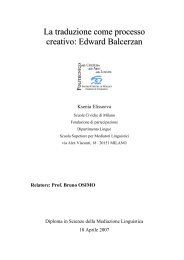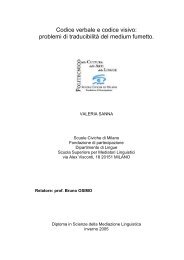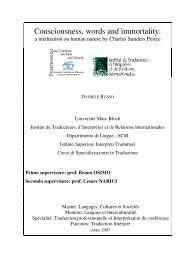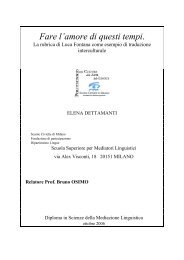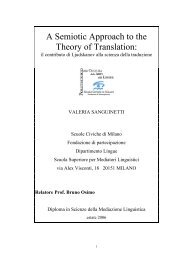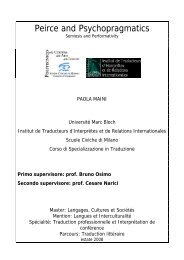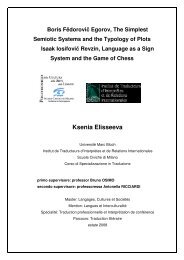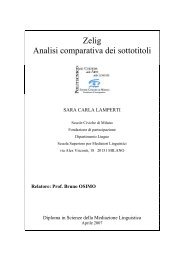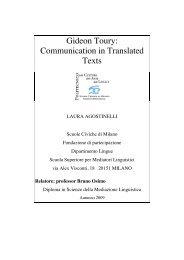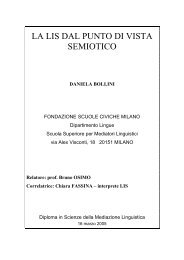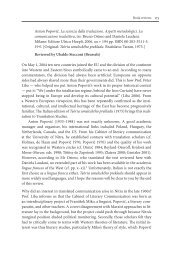Relatore: Professor Bruno OSIMO - Bruno Osimo, traduzioni ...
Relatore: Professor Bruno OSIMO - Bruno Osimo, traduzioni ...
Relatore: Professor Bruno OSIMO - Bruno Osimo, traduzioni ...
You also want an ePaper? Increase the reach of your titles
YUMPU automatically turns print PDFs into web optimized ePapers that Google loves.
Matrat (1992) carried out a systematic comparison of three categories of<br />
subjects (novice, advanced and expert translators) performing translation<br />
tasks in a think-aloud vs. joint activity translating experiment.<br />
Matrat’s approach is embedded in Vygotsky’s psychological theory that<br />
proposes consciousness as “the highest level of organization of mental<br />
functions comprising both intellect and affect”, and thus as “the fundamental<br />
object of psychological research” (Jääskeläinen 1999: 75).<br />
Vygotsky rejected introspective methods and reducing psychology to the<br />
studying of isolated components of mind; he argued that interdisciplinary<br />
research could account for the interrelationship between cultural, linguistic<br />
and psychological phenomena (Matrat 1992). According to him, consciousness<br />
is socially constructed and consequently he proposed that observing joint<br />
activity would be the appropriate method (genetic method) to investigate<br />
human cognitive processes. He also proposed to introduce obstacles and<br />
difficulties into the experimental task in order to disrupt routine methods of<br />
problem-solving and, thus to discover new skills.<br />
In Matrat’s experiment, the three groups of students produced a written<br />
translation of a written source text from English into Italian (their native<br />
language). The same subjects took part in two experiments: first a think-aloud<br />
experiment and then a joint translating activity. The source texts were<br />
different for the two activities, but to retain the same level of difficulty they<br />
were different paragraphs of the same text. The use of dictionary was not<br />
allowed and the time was limited. There appears to have been no articulated<br />
translation brief. The experimental sessions were video-taped.<br />
The setting of Matrat’s experiments shows that more variables may have<br />
contributed to her findings (choice to use text excerpts from the same text,<br />
limited time, no access to reference books). Moreover, a problem arises: when<br />
the subjects started the joint activity, they were already familiar with the<br />
source text.<br />
Matrat compares the collected data in terms of (1) problem definition<br />
and structure and (2) strategic processing. The findings indicate that in joint<br />
27



